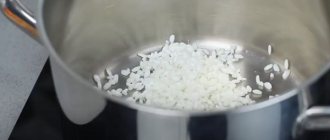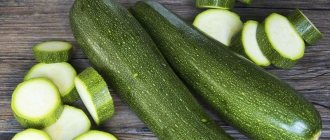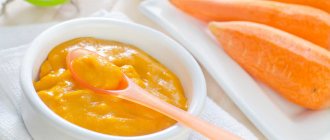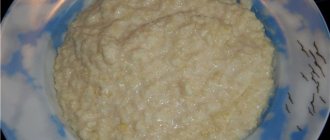Expert: children's allergist, immunologist, pediatrician Nadezhda Viktorovna Ilintseva
The recommendations of the World Health Organization (WHO) state that complementary foods can be introduced to a healthy full-term baby no earlier than 6 months - and it does not matter whether the baby is breastfed or bottle-fed.
Modern pediatricians no longer give strict recommendations on the chronology of complementary feeding, as was done before. Today it is believed that it is necessary to take an individual approach to feeding a child. Still, it is better to take into account some sequence of introduction of complementary foods. So the first complementary food for a baby who is gaining weight well is usually vegetables, and the second is cereals, which deliver B vitamins, vegetable protein, fiber, minerals, and starch to the child’s body. As a rule, porridges begin to be offered to the baby about a month after the introduction of vegetable puree, and thus “porridge time” occurs at the age of 7 months. Pediatricians recommend switching the introduction of vegetable complementary foods and cereals if the baby is not gaining weight well or has signs of malnutrition (eating and digestive disorders).
Which porridge should be introduced first into complementary foods?
Modern pediatricians do not recommend using semolina porridge for complementary feeding. Semolina is rich in starch and protein, but it contains few vitamins and microelements. But the main thing is that semolina contains gluten, which can cause allergic reactions, as well as calcium, which contributes to the manifestations of iron deficiency anemia and excess weight gain. Therefore, it is not recommended to give semolina porridge to children of the first year of life.
It is better to start complementary feeding with gluten-free cereals - buckwheat, corn, rice. Buckwheat is hypoallergenic and one of the most valuable grain products, rich in proteins, microelements, vitamins B1, B2, PP, it contains a lot of magnesium, iron, selenium, and zinc. Rice porridges are characterized by a high starch content and much less protein compared to buckwheat and fewer microelements and vitamins. However, rice porridge is more hypoallergenic than buckwheat, so it is recommended to introduce the first complementary foods with it. Corn porridge contains less starch, but more iron and fiber than rice porridge. It also belongs to the category of hypoallergenic porridge.
When to introduce milk porridges
The introduction of porridge into a child's complementary feeding occurs by 5–6 months of age. It is recommended to do this a month after starting to take fruit and vegetable purees.
If complementary feeding is suitable, then they begin dairy-free options - it is optimal to give gluten-free porridge - buckwheat, corn, rice. Such compositions do not cause allergies. Then they give cereals with gluten - oatmeal, millet, semolina.
They try to eat dairy porridges after the successful introduction of dairy-free ones.
Pediatricians may prescribe early introduction of milk porridges as first complementary foods in the following situations:
- little breast milk;
- the child is gaining little weight;
- there is a lack of B vitamins;
- It is impossible to feed your baby formula or breast milk.
How to introduce complementary foods with porridge?
Complementary feeding with porridge should be introduced gradually and alternately: you should not offer your child several different porridges per day or per week.
It is necessary to introduce complementary foods in fractions, starting not with a whole plate or bottle of porridge, but with 1-2 spoons, increasing the volume of porridge offered daily. While giving this small portion, you will need to supplement your baby with breast milk or formula. Gradually, you will replace one daily breastfeeding or formula feeding with a serving of porridge: this replacement period will take approximately 1-2 weeks while the baby gets used to the introduced complementary foods.
When your child gradually adapts to single-ingredient porridge, you can gradually offer him porridges containing two, three or more grains, as well as fruits and vegetables. For children prone to allergic reactions, it is better to give monocomponent, gluten-free and dairy-free cereals.
Porridge for first feeding
Porridge is one of the most useful and important products in the diet of a child of the first year of life. It is porridge that is most often recommended for introduction as the first complementary food, as it is a rich source of healthy carbohydrates, vegetable proteins, fats and dietary fiber.
As is known, complementary feeding can be introduced in the interval from 4 to 6 months, depending on the individual needs of the child; accordingly, porridge as the first complementary feeding can be prescribed both from 4 and 6 months, or in this interval [1, 2 ].
Complementary feeding begins with porridge, usually if the child is underweight or has a tendency to have loose stools. But here, too, everything is not so simple. Porridge and porridge are different, so their value and safety in a child’s nutrition is determined by many factors.
There are different types of porridge.
Depending on the production, baby cereals are divided into industrial and home-made.
Among industrial cereals there are:
- Instant instant porridges
Such porridges do not need to be cooked. They come in dairy and dairy-free varieties .
Milk porridges are diluted with warm boiled water before consumption.
Before consumption, dairy-free cereals can be diluted with either expressed breast milk or the formula that the baby eats. You need to start complementary feeding with dairy-free porridge, since cow's or goat's milk proteins contained in milk porridge can be strong allergens for a child of the first year of life.
- Porridges, ready to eat. Usually these are milk porridges. They are convenient on the road or for a walk. Before use, you can simply warm them to room temperature.
- Fortified and unfortified porridges . What does it mean?
Industrial cereals are often supplemented with ingredients necessary for growth and development.
the child's vitamins and minerals, including iron, the reserves of which decrease significantly by the age of 4-6 months. Such cereals are called enriched and they are best suited for the first feeding.
Unfortified cereals consist only of grain flour.
- Monocomponent and multicomponent porridges.
If the porridge consists of flour of only one type of grain, it is a monocomponent porridge; if the porridge contains flour of several types of grain crops, it is a multicomponent porridge (can contain up to 2, 4 or more grains). Complementary feeding should be started with monocomponent porridge, so that if the child develops an allergic reaction, it will be easier to identify the possible allergen.
Porridges are also divided into gluten-containing and gluten-free.
Porridges containing gluten are porridges made from wheat, rye, spelled, barley, and oats. In extremely rare cases, gluten is not absorbed by the body and then we are talking about a serious disease called celiac disease, in which these cereals are excluded from the child’s diet. But just in case there is no need to do this. The vast majority of children tolerate gluten-containing cereals well, although in some cases allergic reactions to gluten may develop, so it is better to start complementary feeding with gluten-free cereals (rice, buckwheat, corn).
Which porridges are better: industrial or home-made?
An important advantage of industrially produced cereals is that they are made from environmentally friendly raw materials, have a stable, guaranteed composition, the required degree of grinding, and also that they contain vitamins and minerals necessary for a child of the first year of life, the deficiency of which is widespread and dangerous to the child's health. The amount of vitamins added to industrial cereals is calculated by the manufacturer, taking into account their losses during industrial production and storage.
In homemade porridges, the content of vitamins and minerals is much lower, and in addition, it decreases even more during the cooking process. “Homemade” cereals, of course, can also be used in a child’s diet in the first year of life, but it is better not as the first complementary food, but a little later - after 8-9 months.
So, the ideal porridge for first feeding is industrially produced porridge, instant, dairy-free, monocomponent, gluten-free, enriched, sugar-free.
When is the best time to give porridge?
It is best to offer porridge to your baby for breakfast. From 8-9 months, porridge can be offered for dinner, as a main dish or as a side dish (with vegetables, meat).
What is the best way to give the first porridge for complementary feeding: from a spoon or from a bottle?
Ideally, like any complementary food, it is better to give porridge to your child only from a spoon. At first it may have a thinner consistency, and later, when the child gets used to it, the porridge can be made thicker. An exception may be babies with special needs (for example, premature babies), when it is difficult for them to eat food from a spoon, and then the porridge is poured into a bottle.
How to introduce the first porridge correctly? The introduction of the first porridge should be gradual, but how? On day 1, give your baby 1 tsp. porridge before breastfeeding or formula feeding.
on day 2 – 3 tsp. (15 g)
on day 3 – 6 tsp. (30 g)
on day 4 – 50 g
on day 5 – 100 g
on day 7 – 150 g
You can't spoil porridge with oil.
Oil should be added to any porridge, both homemade and commercially produced. Which? Add butter if the child is not allergic to cow's milk proteins, or vegetable oil (refined olive, sunflower) if there is an allergy. Oil is added to the porridge not from the first day of its introduction, but from the 3-4th day of its introduction1.
1 Program for optimizing feeding of children in the first year of life in the Russian Federation, Moscow 2021, 110 p.
2 Complementary Feeding: A Position Paper by the European Society for Pediatric Gastroenterology, Hepatology, and Nutrition (ESPGHAN) Committee on Nutrition. J Pediatr Gastroenterol Nurt. 2017; 64(1):119-132
Doctor of Medical Sciences, Leading Researcher
nutrition laboratory for healthy and sick children,
Lukoyanova O.L.
Dairy or dairy-free porridge for first feeding? Is it possible to start complementary feeding with milk porridges?
Milk porridge for the first complementary feeding can be used:
- If the child tolerates breast milk and formula well and if he has no skin manifestations when taking milk.
- For complementary feeding, you can choose milk porridge without sugar. However, keep in mind that such a product may additionally contain simple carbohydrates - maltodextrin, fructose, sucrose, glucose. Maltodestrin has a lower glycemic index than sucrose, so it is healthier. Fructose is absorbed twice as slowly in the intestines and does not cause a sharp increase in blood sugar levels. Also know that the label “does not contain crystalline sugar” does not mean that the porridge does not contain sucrose or glucose, because instead of crystals, sugar can be added in the form of syrup or powdered sugar.
- You can start complementary feeding with dairy-free porridge diluted with breast milk or the baby's usual formula.
- Milk porridge for the first feeding can be prepared not with cow's milk, but with goat's milk - it rarely causes allergies and does not contain glucose.
- The first feeding with milk porridges can be started at about 7 months of age.
It's better to start with dairy-free cereals:
- when the child does not tolerate milk and formula;
- when he has a predisposition to lactase deficiency and allergies;
- if one of the baby’s close relatives cannot tolerate milk;
- if you have a negative allergic history in your family.
When and how to introduce dairy products into complementary foods
Where to start complementary feeding with dairy products? Since porridge has already become part of your baby’s diet, it’s time to introduce him to fermented milk products - yogurt, kefir and cottage cheese, which contain protein, mineral salts and vitamins.
Fermented milk products can be obtained at a children's dairy kitchen, or purchased in a store: in this case, they must be marked “for children” and indicate the recommended age of the child for complementary feeding.
Making fermented milk products yourself is not difficult at all. Moreover, in this case you can use not only fresh natural cow’s milk, but also, if possible, goat’s milk, since pediatricians recommend using it as a substitute for cow’s milk, to which food allergies often occur. Goat's milk does not contain glucose and does not increase sugar in the cow, so it is preferable to consume it for diabetes.
To make your own fermented milk product at home, it is enough to purchase milk and a starter culture containing kefir grains, which is sold at the pharmacy. It will take approximately 8-12 hours to prepare such a product at home. Bifidobacteria contained in fermented milk will support the functioning of the intestinal microflora, normalize the digestive tract (especially if the baby has constipation), and reduce the possibility of developing infectious diseases.
When to introduce dairy products into baby's complementary foods
Some pediatricians believe that you can start complementary feeding with fermented milk products after the child has tried not only milk porridge, but also meat, that is, at about 9 months. Other doctors are confident that it is better to give meat to a child after the introduction of vegetables, cereals and fermented milk complementary foods. And offer kefir, yogurt and cottage cheese at 8 months. In fact, a mother can follow one of these recommendations depending on her own taste preferences, as well as the child’s health. But if in doubt, it is better to consult a pediatric nutritionist.
Pediatricians recommend starting fermented milk complementary foods with kefir - with small portions in a spoon, gradually increasing the total volume to 1 glass per day.
If the child’s body tolerates kefir complementary foods well, you can diversify them by replacing kefir with baby yogurt - preparing it is just as easy with milk and pharmacy yogurt starter. Until the child is one year old, you should not exceed the dose of fermented milk product and give the baby more than 200 ml per day or offer both products on the same day.
Having fallen in love with kefir and yogurt, your child will certainly love cottage cheese, which is very rich in calcium and protein. You can also either get cottage cheese from a children's dairy kitchen, buy it in a store, or prepare it yourself using sourdough starter. However, in case of kidney disease and excess body weight, pediatricians recommend postponing feeding the child cottage cheese for up to a year. But if there is a deficiency of body weight, as well as a lack of calcium in the baby’s body, cottage cheese, on the contrary, can be recommended even before complementary feeding with kefir and yogurt. Start giving your child cottage cheese with half a teaspoon per day, gradually increasing the daily portion to 50 grams by the time the baby is one year old.
Gradually, you can add fruits and vegetable purees to the cottage cheese, which the baby has already tried and to which his body responds well.
How to introduce milk porridge into a child's diet
In order for milk porridges to bring maximum benefits, it is enough to follow a few simple rules.
Do not rush to introduce milk porridges into complementary foods. Pediatricians recommend starting complementary feeding of milk porridges to infants only after the child has already become familiar with dairy-free cereal complementary foods. This is due to the fact that cow's milk proteins are among the most common allergens in children with food hypersensitivity. In order not to provoke the baby’s immune system and not cause disruptions in it in the form of allergic reactions, it is worth gradually introducing it to new products. And only after the child has responded well to dairy-free cereals can dairy ones be introduced.
Introduce new types of grains gradually. The first milk porridges should contain those cereals that have already been tested as complementary foods with dairy-free products. New grains in milk porridges should also be introduced gradually in order to understand in time which of them cause intolerance or allergies. This requirement is relevant in all cases, including if complementary feeding with cereals begins with milk.
Watch your child's reaction carefully. Any products, including milk porridges, require attention to the child’s condition. After introducing a new component into the baby’s diet, you need to monitor his behavior, skin, sleep, and stool. Any negative changes, such as moodiness and irritability, restless shallow sleep, skin rashes, loose stools or a bloated tummy, are a reason to temporarily abandon the product. This does not necessarily mean that the new grain in the porridge or milk is the cause of the allergy. Most often, the child just needs to grow up a little and his digestive system needs to “mature” in order to learn to digest this product.











